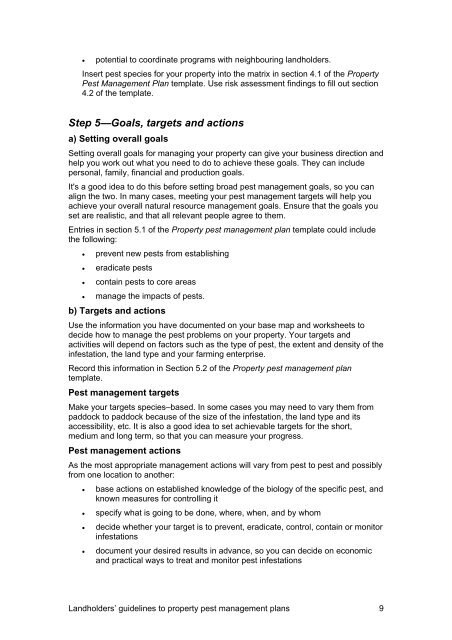Landholders' guidelines to property pest management plans (PDF ...
Landholders' guidelines to property pest management plans (PDF ...
Landholders' guidelines to property pest management plans (PDF ...
You also want an ePaper? Increase the reach of your titles
YUMPU automatically turns print PDFs into web optimized ePapers that Google loves.
potential <strong>to</strong> coordinate programs with neighbouring landholders.<br />
Insert <strong>pest</strong> species for your <strong>property</strong> in<strong>to</strong> the matrix in section 4.1 of the Property<br />
Pest Management Plan template. Use risk assessment findings <strong>to</strong> fill out section<br />
4.2 of the template.<br />
Step 5—Goals, targets and actions<br />
a) Setting overall goals<br />
Setting overall goals for managing your <strong>property</strong> can give your business direction and<br />
help you work out what you need <strong>to</strong> do <strong>to</strong> achieve these goals. They can include<br />
personal, family, financial and production goals.<br />
It's a good idea <strong>to</strong> do this before setting broad <strong>pest</strong> <strong>management</strong> goals, so you can<br />
align the two. In many cases, meeting your <strong>pest</strong> <strong>management</strong> targets will help you<br />
achieve your overall natural resource <strong>management</strong> goals. Ensure that the goals you<br />
set are realistic, and that all relevant people agree <strong>to</strong> them.<br />
Entries in section 5.1 of the Property <strong>pest</strong> <strong>management</strong> plan template could include<br />
the following:<br />
prevent new <strong>pest</strong>s from establishing<br />
eradicate <strong>pest</strong>s<br />
contain <strong>pest</strong>s <strong>to</strong> core areas<br />
manage the impacts of <strong>pest</strong>s.<br />
b) Targets and actions<br />
Use the information you have documented on your base map and worksheets <strong>to</strong><br />
decide how <strong>to</strong> manage the <strong>pest</strong> problems on your <strong>property</strong>. Your targets and<br />
activities will depend on fac<strong>to</strong>rs such as the type of <strong>pest</strong>, the extent and density of the<br />
infestation, the land type and your farming enterprise.<br />
Record this information in Section 5.2 of the Property <strong>pest</strong> <strong>management</strong> plan<br />
template.<br />
Pest <strong>management</strong> targets<br />
Make your targets species–based. In some cases you may need <strong>to</strong> vary them from<br />
paddock <strong>to</strong> paddock because of the size of the infestation, the land type and its<br />
accessibility, etc. It is also a good idea <strong>to</strong> set achievable targets for the short,<br />
medium and long term, so that you can measure your progress.<br />
Pest <strong>management</strong> actions<br />
As the most appropriate <strong>management</strong> actions will vary from <strong>pest</strong> <strong>to</strong> <strong>pest</strong> and possibly<br />
from one location <strong>to</strong> another:<br />
<br />
<br />
<br />
<br />
base actions on established knowledge of the biology of the specific <strong>pest</strong>, and<br />
known measures for controlling it<br />
specify what is going <strong>to</strong> be done, where, when, and by whom<br />
decide whether your target is <strong>to</strong> prevent, eradicate, control, contain or moni<strong>to</strong>r<br />
infestations<br />
document your desired results in advance, so you can decide on economic<br />
and practical ways <strong>to</strong> treat and moni<strong>to</strong>r <strong>pest</strong> infestations<br />
Landholders’ <strong>guidelines</strong> <strong>to</strong> <strong>property</strong> <strong>pest</strong> <strong>management</strong> <strong>plans</strong> 9
















